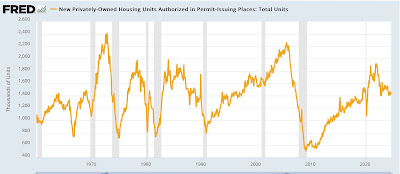- by New Deal democrat
Housing data for October, like that for September, has to be viewed with an asterisk, due to Hurricanes Helene and Milton. Since the effects of both were in the South Census Region, where relevant in the analysis below I will also discuss the numbers excluding that region.
The most leading metric, after revisions housing permits (gold in the graph below), declined -9,000 to 1.416 million. Excluding the South Census Region, permits increased 5,000. Single family permits (red), which are just as leading and have very little noise, rose 5,000 to 968,000, with revisions the highest since April. Excluding the South, they would have been unchanged. Housing starts (blue), which tend to lag permits by a month or two, and are much more noisy, declined -42,000 to 1.311 million. Excluding the South, they *rose* 20,000:
Accounting for the regional issues, this is a slight rebound from lows earlier this year, and it is what I have been expecting, for the simple reason that for 60+ years, mortgage rates have always led housing permits, and over the summer mortgage rates declined:
Given the upturn in mortgage rates in the past two months, this mild upturn is likely to be short-lived - although I am not expecting any new lows.
The bad news is that units under construction, the measure of real economic activity in this sector, declined another -29,000 (-19,000 excluding the South), or another 1.7% from its October 2022 peak, and is now down -14.4% from that peak.
This is very important, because in the past it has declined on average -15.1% and by a median of 13.4% before the onset of recessions:
Two months ago I hoisted a yellow flag “recession watch” for the construction sector, based on this metric being down more than -10%. As of last month, and certainly continuing this month, it is at the level consistent on average in the past with the onset of a recession. The only reason I am not hoisting a red flag now is that, excluding the South, units under construction are only down -12.4%:
There are several other silver linings which suggest that we should not put too much weight on this decline. The first is that in the lead-up to past recessions, the downturn was led by single family units under construction, the number of which continued to decline into recessions. This year the number of single family units under construction has remained stable for the past four months (far right of graph below):
Additionally, as shown in the long historical view of housing permits, with the exception of the tech producer-centered recession of 2001, they continued to decline sharply into the recession, and typically well after recessions had begun:
In our present situation, since it appears permits have bottomed, then housing units under construction will not decline too much further before bottoming as well.
For those reasons, at this point there is only a housing sector ‘recession watch,’ meaning a heightened possibility, and not a ‘warning,’ meaning one is more likely than not. Once the hurricanes-induced asterisks are resolved, the issue will become whether mortgage rates continue to head back higher - in which case recession risks increase - or are at the top of their range going forward.





